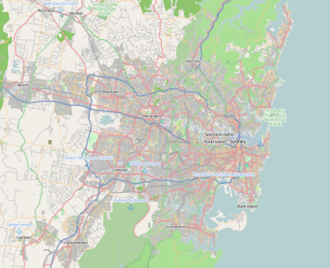Early history of St Matthew's Parish
Early colonial New South Wales was Anglican, and officially appointed Catholic priests only obtained permission from the British Government to come to the Colony in 1819, arriving in 1820. Early conditions were difficult, with church services being held in private homes or barns. At Windsor, the new Convict Barracks was able to be used for a time, until it was converted into a hospital. While a church was needed, the parishioners of the district were not financial enough to raise enough funds to build one, and progress was slow. [7]
An anecdote printed in a history of St Matthew's catholic Church relates that in the early days of settlement, the government decreed that each convict must worship on a Sunday. In the Hawkesbury area, it was ordered that prisoners worship “at St Matthew’s” (that is, St Matthew's Anglican Church, Windsor, which opened in 1822). In order to remain within the confines of the law, but to celebrate Mass instead of a Protestant service, the local Catholics called their church "St Matthew’s" too. This is reputedly why Windsor has two St Matthew's churches within walking distance of each other. [8]
A grant of land was obtained in 1833 for a Roman Catholic church and cemetery in Windsor, although Catholic burials had been occurring locally well before this (the earliest known burial was of the remains of a man called Patrick Cullen, in 1822). The cemetery covered an area of three acres and one rood. [9]
In 1834, the plan of Windsor showed the present site of the church (at modern Tebbut and Little Church Street) as being part of the Church Green (this probably being a reference to the nearby St Matthew's Anglican Church) and the adjacent farm, “Catherine Farm”. [10]
Construction of St Matthew's Church
Lack of funds for building ceased to be an issue in 1836, when a bequest of 500 pounds in the Will of former convict James Doyle allowed construction to commence.
On 1 May 1836, Bishop Polding wrote, in a letter to Rev. Thomas Heptonstall that he had visited Windsor the
Sunday before last and celebrated Mass in our temporary chapel there. It was a barn and will be one again, made of slabs. A man by the name of Doyle died there a few weeks since, and he left five hundred pounds to build a church and two hundred pounds for a school. I hope to obtain as much from the government for the same purposes and to complete the two this year. [11]
St Matthew's foundation stone was laid before the year was out, on 28 December 1836. Building of the church proceeded for nearly four years, and it was opened on 21 October 1840 with great ceremony by the Bishop of Sydney, the Right Rev. John Bede Polding, with the sermon being preached by the Very Rev. Dr William Ullathorne. The procession to the church was accompanied by the band of the 80th Regiment, and the choir of St Mary's Cathedral, Sydney, was also present for the service. [12] [13]
According to a District Surveyor's Plan dated 1889, modern Tebbutt Street used to be known as Glebe Street, and modern Little Church Street as simply Church Street. [14]
The Church was designed in a cruciform shape with a porch at the front, and is possibly the first Australian Catholic Church designed with transepts. Although supposedly designed to seat 1,200 people, it accommodated around 350. The external walls are stuccoed brick with corner and intermediate buttresses, small transepts all originally with a shingled roof, but now with corrugated iron. The choir loft and a circular leadlight window high in the façade facing Tebbutt Street were added later. [15] [16]
